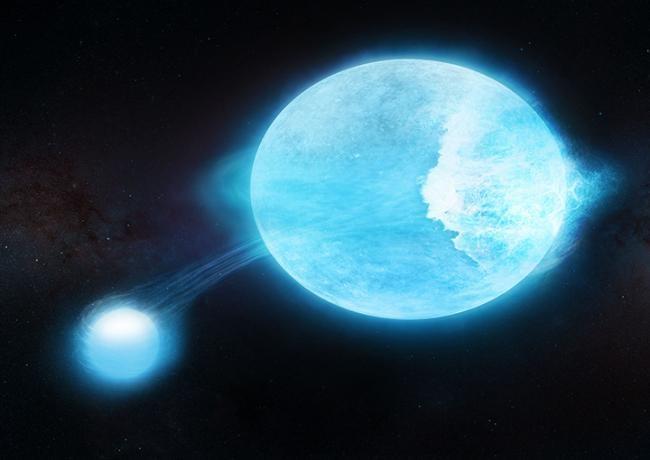Astronomers have found a binary star system where huge “tidal waves” are breaking on the one of the stars. It’s the first time anything like this has been observed and the tidal waves are so powerful they could disintegrate Earth, according to the researchers.
It’s happening in the Large Magellanic Cloud, one of the two dwarf galaxies that orbit our own Milky Way galaxy. The star system—called MACHO 80.7443.1718—is about 169,000 light-years distant.
Heartbeat Stars
At the center of this system is a star 35 times the mass of our sun along with a much smaller star, which orbit each other very closely in an oval shape. It’s called a “heartbeat star” because they periodically pulse in brightness, like the rhythm of a beating heart.
Published this week in Nature Astronomy, what the researchers found was that whenever the two stars swing close to each other their gravities generate tides, rather like the Earth and moon do. These tides appear to create titanic waves that cause a huge bulge in the shape of the giant star.
Crashing Down
This is normal on “heartbeat stars,” but on this one the brightness fluctuations are extreme—about 200 times greater than expected. As the smaller star gets closer to the larger star the latter suffers tidal waves that get to huge heights before crashing down on its surface.
“Each crash of the star’s towering tidal waves releases enough energy to disintegrate our entire planet several hundred times over,” said lead author Morgan MacLeod, a Postdoctoral Fellow in Theoretical Astrophysics at the Center for Astrophysics, Harvard and Smithsonian. “We don’t know of any other heartbeat star that varies this wildly.”
Breaking Waves
Although lucky to be observing during the event—which occurs about once per month—MacLeod had to create a computer model to discover exactly what was going on. It revealed that the two stars’ interacting gravity causes tidal waves on the giant star as big as about a fifth of the giant star’s radius—about 2.7 million miles high. It also showed the waves breaking, just as they do in Earth’s oceans, with material is flung outward.
It’s the first time anything this extreme has been observed but it probably won’t be the last. “We’re already planning a search for more heartbreak stars, looking for the glowing atmospheres flung off by their breaking waves,” says MacLeod. About 1,000 heartbeat stars are known and around 20 fluctuate wildly in brightness.
Wishing you clear skies and wide eyes.
Read the full article here










